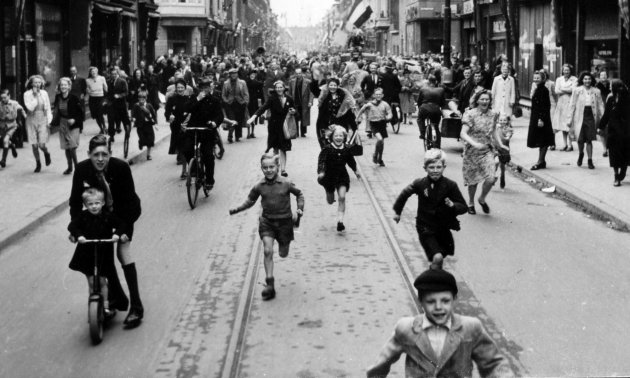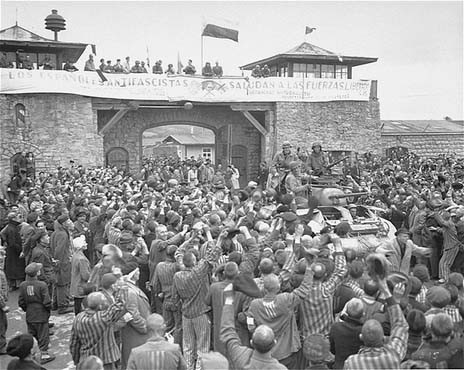



Source: Eurotopics
The invasion of Normandy on D-Day in June of 1944 signalled the beginning of the end for the Axis powers. From that fateful encounter, the Allies in Europe closed in and by May 1945 the European Axis powers had surrendered. After the dropping of atomic bombs on the cities of Nagasaki and Hiroshima in August of 1945 by American forces, Japan also surrendered and World War II was officially over. Read through the resources below to learn about the decisive military action that brought about the end of the war and the immediate aftermath of the end of the war.
While 2 September 1945 is generally recognised as the final, official end of the Second World War, in many parts of the world fighting continued long beyond that date. And, given the vast scale of the war, which involved troops from every part of the world, it did not simultaneously come to an end everywhere. Instead, it ended in stages. Historian Keith Lowe explains how and when the war officially concluded, and asks – how important were the atomic bombs dropped over Japan in ending WW2?
World War II ended with the unconditional surrender of Germany in May 1945, but both May 8 and May 9 are celebrated as Victory in Europe Day (or V-E Day). This double celebration occurs because the Germans surrendered to the Western Allies, including Britain and the U.S., on May 8, and a separate surrender took place on May 9 in Russia. In the East, the war ended when Japan surrendered unconditionally on Aug. 14, 1945, signing their surrender on Sept. 2. The Japanese surrender occurred after the United States dropped atomic bombs on Hiroshima and Nagasaki on Aug. 6 and 9, respectively. The date of the Japanese surrender is known as Victory Over Japan Day, or V-J Day. Read through this article to learn more.
The landing by Allied troops on the beaches of Normandy could have been 'the most ghastly disaster of the whole war'. Duncan Anderson explains how meticulous planning, good luck and sheer guts made D-Day one of the greatest triumphs.
Airmen were among the first Australian service men to deploy overseas in support of the United Kingdom. When the war ended, the RAAF was flying operations against Japanese forces in the south-west Pacific. This poster was released for the 75th anniversary of the end of the Second World War.
For more than 5 years during the war, the Australian troops served in campaigns from North Africa to the Solomon Islands. This poster was released for the 75th anniversary of the end of the Second World War.
V-bombs and boy soldiers: the unlikely partners relied upon to save the crumbling Third Reich. Louise Wilmot examines Hitler's increasingly desperate attempts to turn the tide of war.
By the end of World War Two, Japan had endured 14 years of war, and lay in ruins - with over three million dead. Why did the war in Japan cost so much, and what led so many to fight on after the end of the hostilities?
In the space of three crucial months in 1944, the Allies progressed from landing 150,000 troops on five Normandy beaches, to a victory march through Paris. Lloyd Clark charts the remarkable execution of Operation Overlord.
A last ditch attempt to inflict damage on the enemy? Robin Cross examines Hitler's decision to go on the offensive after identifying the soft underbelly of the Allies' military - the poorly defended 80-mile front in the Ardennes.
When the Allies prevented a typhus epidemic by burning down the Belsen concentration camp, they also destroyed a monument to man's inhumanity to man. Stephen A Hart charts the arrival of a liberating army at what seemed like a hell on earth.
Stalin's attempt to take Berlin ahead of his allies in 1945, led to the death of 70,000 Russian soldiers. Tilman Remme followed historian Antony Beevor as he examined the conquering army's conduct, and unearthed evidence that might explain why the Soviet leader took such risks.
The end of the war in Europe was met with a mixture of euphoria, sombre reflection and, in some cases, indifference. Gary Sheffield examines how the defeat of Hitler's Germany was greeted in Britain and around the world.
Was it right for the Americans to drop nuclear bombs on Hiroshima and Nagasaki? Conventional wisdom has it that the decision saved many lives in the long run, but this view has been frequently challenged.
Professor Richard Overy discusses how the Allies overcame the initially overwhelming setbacks of World War Two, and succeeded in finally defeating the Axis Powers.
The Allies celebrated victory over Japan on 15 August 1945, although the Japanese administration under General Koiso did not officially surrender with a signed document until 2 September. Both dates are known as VJ Day. Read through this article to learn more.
In spring 1945, war with Germany was drawing to a close. While the British government was dealing with a country in the grip of rationing and cities ravaged by bombs, some ministers had to turn their thoughts to how people could celebrate victory after six years of war. Enter the ‘Office Committee for the Coordination of Departmental Action on the End of Hostilities in Europe.’ Read through this article to learn more.
On May 8, 1945, World War II in Europe came to an end. As the news of Germany’s surrender reached the rest of the world, joyous crowds gathered to celebrate in the streets, clutching newspapers that declared Victory in Europe (V-E Day). Later that year, US President Harry S. Truman announced Japan’s surrender and the end of World War II. The news spread quickly and celebrations erupted across the United States. On September 2, 1945, formal surrender documents were signed aboard the USS Missouri, designating the day as the official Victory over Japan Day (V-J Day). Read through this website to learn more.
After the Interim Committee decided to drop the bomb, the Target Committee determined the locations to be hit, and President Truman issued the Potsdam Proclamation as Japan’s final warning, the world soon learned the meaning of “complete and utter destruction.” The first two atomic bombs ever used were dropped on Japan in early August, 1945. Read through this article to learn more.
This website gives an hour by hour breakdown of the bombings.
The Manhattan Project: An Interactive History is intended to provide an overview of the Manhattan Project. Five main topical areas-Events, People, Places, Processes, and Science-are further divided into sub-sections, each with an introductory page and as many as a dozen or more sub-pages.
On August 6, 1945, the United States dropped an atomic bomb on the city of Hiroshima, Japan. Three days later, on August 9, 1945, the US dropped a second atomic bomb on Nagasaki. These remain the only two instances of nuclear weapons being used in warfare to this day. The second world war commenced in 1939. While the war in Europe ended on May 8, 1945, the war in the Pacific only ended with Japan’s unconditional surrender to the Allies on August 15, 1945. The atomic bombing of Japan was a hugely significant final act of the most destructive global conflict in human history. Simultaneously, it signalled the dawn of the atomic age, the arms race between the US and the Soviet Union and - before too long - the cold war. Read through this article to learn more.
As the world celebrated victory over Nazi Germany and the boys eventually did come home, the war they fought thousands of miles from American shores came home with them. It came home with them in their wounds, in their memories, in their daily life…in their nightmares. Read through this article to learn more.
Dr. Rob Citino highlights the moments of celebration, as well as realization of the repercussions that followed Allied victory and the end of World War II.
Japanese military leaders debated Japan's possible surrender up to the last moment. Emperor Hirohito's intervention was critical. Read through this article to learn more.
Although a decision to continue the war would mean national suicide, members of the Japanese military came close to refusing Emperor Hirohito’s surrender order. Read through this article to learn more.
Monuments and fields of white crosses mark the cost of victory in Europe. Majestic today, the cemeteries were in a much different state 75 years ago. Read through this article to learn more.
On the morning of August 6, 1945, the American B-29 bomber Enola Gay dropped an atomic bomb on the Japanese city of Hiroshima. A few days later, the Japanese would surrender. Read through this article to learn more.
The bombing of the Japanese city of Nagasaki with the Fat Man plutonium bomb device on August 9, 1945, caused terrible human devastation and helped end World War II. Read through this article to learn more.
This website describes the process of liberation of the concentration camps, with a timeline, as well as providing links to accounts from survivors.
As the Allies advanced across Europe at the end of the Second World War, they came across concentration camps filled with sick and starving prisoners. Read through this article to learn more.
After the war, Allied powers—United States, Great Britain, France, and the Soviet Union—came together to form the International Military Tribunal (IMT). From 1945 to 1946, Nazi Germany leaders stood trial for crimes against peace, war crimes, crimes against humanity, and conspiracy to commit any of the foregoing crimes. Read through this website to learn more.
After the war, the top surviving German leaders were tried for Nazi Germany’s crimes, including the crimes of the Holocaust. Their trial was held before an International Military Tribunal (IMT) in Nuremberg, Germany. Judges from the Allied powers—Great Britain, France, the Soviet Union, and the United States—presided over the hearing of 22 major Nazi criminals. Read through this website to learn more.
In the aftermath of World War Two the Allies sought to bring the aggressors to justice. How did the surviving Nazi leaders give account for their actions?
Did the flawed justice of the Nuremberg trials achieve a better result than Britain's preferred plan of simply shooting Nazi war criminals as and when they were found?

To the cheers of the survivors behind them, British soldiers arrest Josef Kramer, the former commandant of Auschwitz-Birkenau killing center and Bergen-Belsen concentration camp.

Survivors of Mauthausen cheer American soldiers as they pass through the main gate of the camp. The photograph was taken several days after the liberation of the camp. Mauthausen, Austria, May 9, 1945.

In early April 1945, as US forces approached the camp, the Germans began to evacuate some 28,000 prisoners from the main camp and an additional several thousand prisoners from the subcamps of Buchenwald. About a third of these prisoners died from exhaustion en route or shortly after arrival, or were shot by the SS. The underground resistance organization in Buchenwald, whose members held key administrative posts in the camp, saved many lives. They obstructed Nazi orders and delayed the evacuation.
